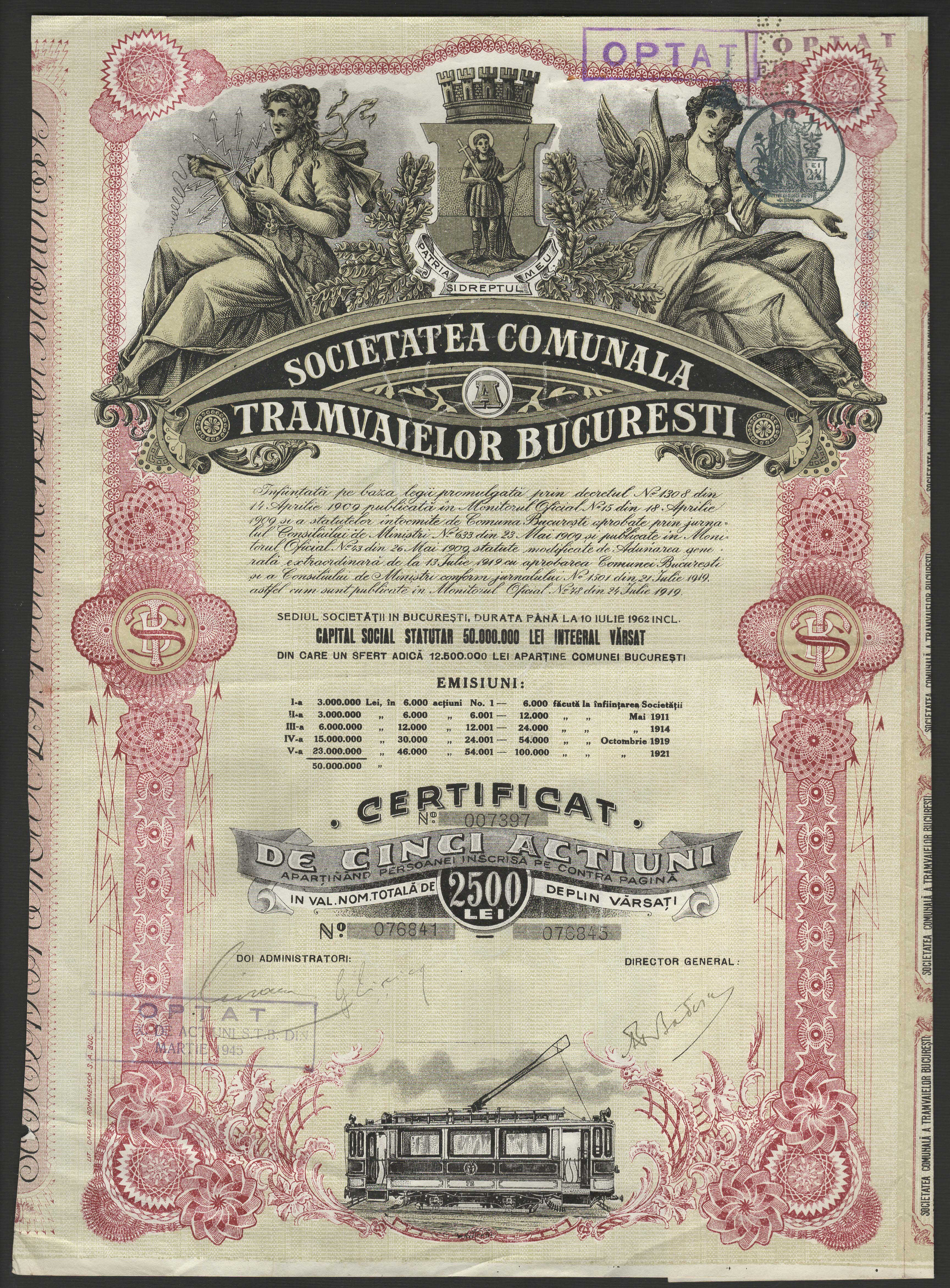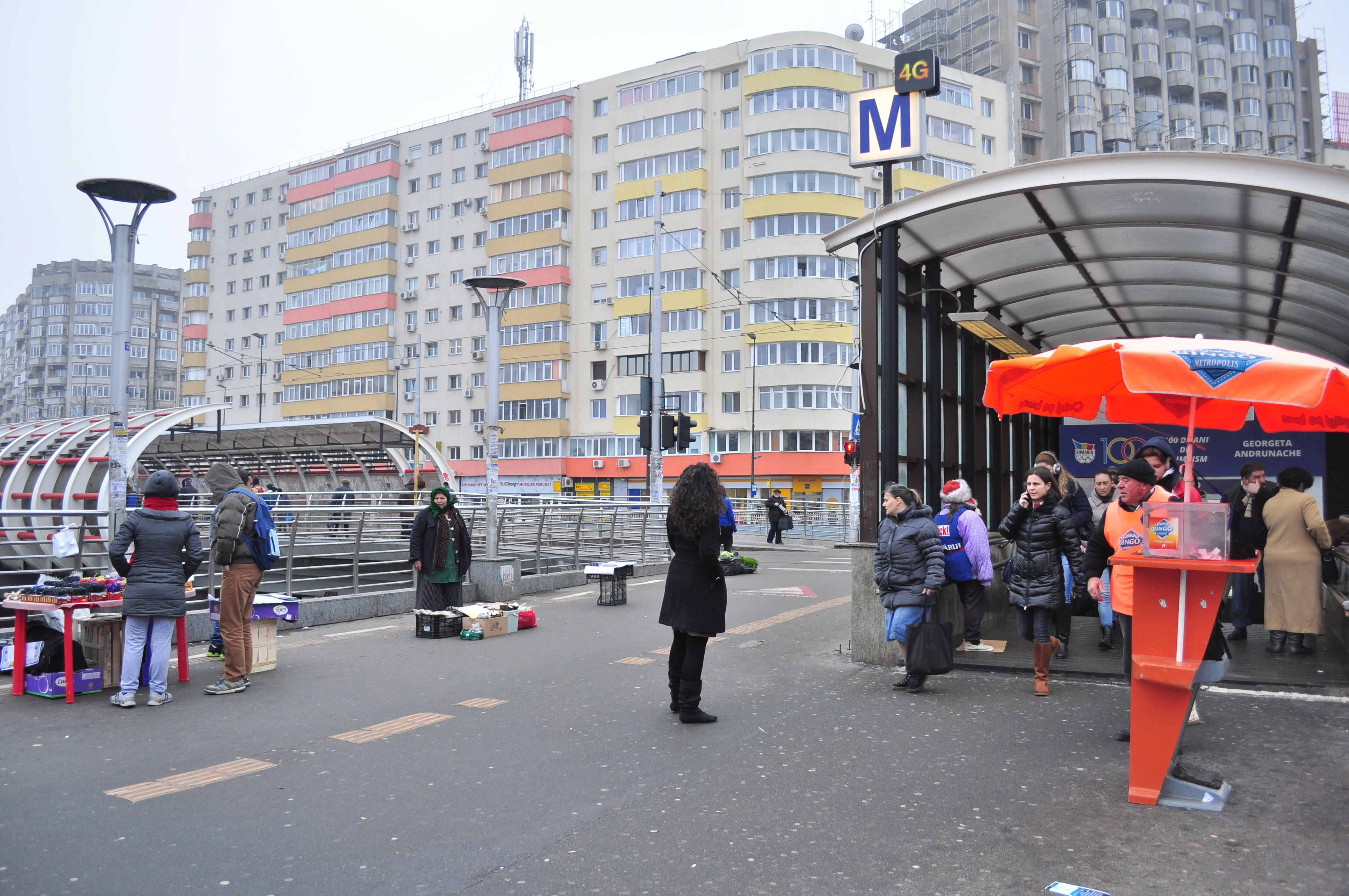|
Obor Metro Station
Obor is a metro station in Bucharest, located next to one of the largest open-air markets in Bucharest, Obor. The station was closed for over 10 months, until May 25, 2008, for refurbishment and in order to facilitate the building of a new overground passage for the tram above ground. This station is painted in blue, with pillars separating the two parts of the station. It is currently served by the M1 line. Connections with STB services are 1, 21, 46 (trams), 330 and 335 (buses). The current station was built in 1979 once with the completion of the Obor underpass. Before 1989 a tram line used to run where the current station is located, integrating a tram stop in the underpass. After the construction of the metro the tram tracks were moved above, and in 2008 they were separated from the road, at the same time when the metro station was closed. The metro station was opened on 17 August 1989 as part of the extension from Gara de Nord Bucharest North railway station ( ro, Gara Bu ... [...More Info...] [...Related Items...] OR: [Wikipedia] [Google] [Baidu] |
Sector 2 (Bucharest)
Sector 2 ( ro, Sectorul 2) is an administrative unit of Bucharest. Demographics Sector 2 is the city's most multicultural sector. In particular, it contains Romania's largest community of Chinese people, who mainly live in the districts of Colentina and Obor. Economy Air Bucharest has its head office in Sector 2. Air Bucharest. Retrieved on 31 December 2010. "Address: Str. Amidonului Street, No. 28 , Sector 2, Postal Code 023808, București, Romania Address in Romanian : "Adresa: Str. Amidonului nr 28 , Sector 2, Cod poștal 023808, București, Romania." Boroughs *[...More Info...] [...Related Items...] OR: [Wikipedia] [Google] [Baidu] |
Bucharest
Bucharest ( , ; ro, București ) is the capital and largest city of Romania, as well as its cultural, industrial, and financial centre. It is located in the southeast of the country, on the banks of the Dâmbovița River, less than north of the Danube River and the Bulgarian border. Bucharest was first mentioned in documents in 1459. The city became the capital of Romania in 1862 and is the centre of Romanian media, culture, and art. Its architecture is a mix of historical (mostly Eclectic, but also Neoclassical and Art Nouveau), interbellum ( Bauhaus, Art Deco and Romanian Revival architecture), socialist era, and modern. In the period between the two World Wars, the city's elegant architecture and the sophistication of its elite earned Bucharest the nickname of 'Paris of the East' ( ro, Parisul Estului) or 'Little Paris' ( ro, Micul Paris). Although buildings and districts in the historic city centre were heavily damaged or destroyed by war, earthquakes, and even Nic ... [...More Info...] [...Related Items...] OR: [Wikipedia] [Google] [Baidu] |
Romania
Romania ( ; ro, România ) is a country located at the crossroads of Central, Eastern, and Southeastern Europe. It borders Bulgaria to the south, Ukraine to the north, Hungary to the west, Serbia to the southwest, Moldova to the east, and the Black Sea to the southeast. It has a predominantly temperate-continental climate, and an area of , with a population of around 19 million. Romania is the twelfth-largest country in Europe and the sixth-most populous member state of the European Union. Its capital and largest city is Bucharest, followed by Iași, Cluj-Napoca, Timișoara, Constanța, Craiova, Brașov, and Galați. The Danube, Europe's second-longest river, rises in Germany's Black Forest and flows in a southeasterly direction for , before emptying into Romania's Danube Delta. The Carpathian Mountains, which cross Romania from the north to the southwest, include Moldoveanu Peak, at an altitude of . Settlement in what is now Romania began in the Lower Paleolithic, with ... [...More Info...] [...Related Items...] OR: [Wikipedia] [Google] [Baidu] |
Side Platforms
A side platform (also known as a marginal platform or a single-face platform) is a platform positioned to the side of one or more railway tracks or guideways at a railway station, tram stop, or transitway. A station having dual side platforms, one for each direction of travel, is the basic design used for double-track railway lines (as opposed to, for instance, the island platform where a single platform lies between the tracks). Side platforms may result in a wider overall footprint for the station compared with an island platform where a single width of platform can be shared by riders using either track. In some stations, the two side platforms are connected by a footbridge running above and over the tracks. While a pair of side platforms is often provided on a dual-track line, a single side platform is usually sufficient for a single-track line. Layout Where the station is close to a level crossing (grade crossing) the platforms may either be on the same side of the cross ... [...More Info...] [...Related Items...] OR: [Wikipedia] [Google] [Baidu] |
Obor
Obor is the name of a square and the surrounding district of Bucharest, the capital of Romania. There is also a Bucharest Metro station (on the M1 line) named Obor, which lies in this area. The district is near the Colentina and Moșilor neighborhoods. Obor stands in the place of "Târgul Moșilor", a fair famous throughout Wallachia, which was held twice a week. In Old Romanian, "''obor''" meant ''enclosure, corral''. Located outside the city, in the 18th century, it was also the place for public hangings. About 20 Turks captured from wars were hanged here by the Romanians. ''Magazin Istoric'', no. 461. August 2005 The Obor market (Piața Obor), the direct successor of the original fair, was, until 2007, Bucharest's largest public marke ... [...More Info...] [...Related Items...] OR: [Wikipedia] [Google] [Baidu] |
Societatea De Transport București
'' Societatea de Transport București (STB; English: Bucharest Transit Corporation) is one of the main public transit operators in Bucharest, Romania, owned by the Municipality of Bucharest. From 1990 to 2018, the company had a different legal status and was known as the ''Regia Autonomă de Transport București'' (''RATB''). STB operates a complex network of buses, trolleybuses, light rail and trams – in fact, STB operates all public transport except the Bucharest Metro, which is managed by Metrorex. STB has an average of approximately 1,180,000 daily individual rides of which 540,000 with buses, 520,000 with light rail and trams, and 120,000 with trolleybuses. Overview While owned entirely by the City Council, STB is an autonomous company. On 13 September 2018, it became a public company (Romanian: ''Societate pe acțiuni'') and adopted its current name (not to be confused with the pre-WWII name ''Societatea de Tramvaie București''). The Municipality of Bucharest is t ... [...More Info...] [...Related Items...] OR: [Wikipedia] [Google] [Baidu] |
Gara De Nord Metro Station
Gara de Nord is the name of two separate metro stations, situated near Gara de Nord train station in Bucharest and serving lines M1 and M4. Neither of the metro stations nor the railway station are interconnected, passengers being required to use the next station ( Basarab) to switch from M1 to M4 directly, without having to validate a ticket. The first station was opened on 24 December 1987 as the eastern terminus on an extension from Crângași. On 17 August 1989, the extension to Dristor Dristor is a neighborhood located in the southeastern part of Bucharest, Romania Romania ( ; ro, România ) is a country located at the crossroads of Central, Eastern, and Southeastern Europe. It borders Bulgaria to the south, Ukraine t ... was opened. The M4 station was opened on 1 March 2000 as part of the inaugural section of the line from Gara de Nord to 1 Mai. It is very unusual mainly due to its story: Initially designed as a bilevel station, the layout of it was heavily ... [...More Info...] [...Related Items...] OR: [Wikipedia] [Google] [Baidu] |
Dristor Metro Station
Dristor is a major metro station in Bucharest. It is located on the Bd. Camil Ressu – Șoseaua Mihai Bravu – Calea Dudești junction. The part of the station at the end of metro line 1 is called Dristor 2; the other half of the station is Dristor 1, where trains of metro line M1/M3 pass through. Having two separately named parts of the station can cause confusion for people because both parts of the station have metro line M1 either passing through, which occurs at Dristor 1, or terminating and beginning service at Dristor 2. Signs guide passenger to either terminals. Dristor 1 is where M3 service and through M1 service stops. It is above Dristor 2 and has one island platform. Dristor 2 has one island platform and is the terminus of line M1. A passageway at the south end of the platform connects it to Dristor 1. The station was opened on 28 December 1981 as part of the section between Timpuri Noi and Republica. On 17 August 1989, the section between Dristor and Gara de Nord ... [...More Info...] [...Related Items...] OR: [Wikipedia] [Google] [Baidu] |
Obor Metro Station 1
Obor is the name of a square and the surrounding district of Bucharest, the capital of Romania. There is also a Bucharest Metro station (on the M1 line) named Obor, which lies in this area. The district is near the Colentina and Moșilor neighborhoods. Obor stands in the place of "Târgul Moșilor", a fair famous throughout Wallachia, which was held twice a week. In Old Romanian, "''obor''" meant ''enclosure, corral''. Located outside the city, in the 18th century, it was also the place for public hangings. About 20 Turks captured from wars were hanged here by the Romanians. ''Magazin Istoric'', no. 461. August 2005 The Obor market (Piața Obor), the direct successor of the original fair, was, until 2007, Bucharest's largest public market. ... [...More Info...] [...Related Items...] OR: [Wikipedia] [Google] [Baidu] |
Bucharest Metro Stations
Bucharest ( , ; ro, București ) is the capital and largest city of Romania, as well as its cultural, industrial, and financial centre. It is located in the southeast of the country, on the banks of the Dâmbovița River, less than north of the Danube River and the Bulgarian border. Bucharest was first mentioned in documents in 1459. The city became the capital of Romania in 1862 and is the centre of Romanian media, culture, and art. Its architecture is a mix of historical (mostly Eclectic, but also Neoclassical and Art Nouveau), interbellum (Bauhaus, Art Deco and Romanian Revival architecture), socialist era, and modern. In the period between the two World Wars, the city's elegant architecture and the sophistication of its elite earned Bucharest the nickname of 'Paris of the East' ( ro, Parisul Estului) or 'Little Paris' ( ro, Micul Paris). Although buildings and districts in the historic city centre were heavily damaged or destroyed by war, earthquakes, and even Nicolae ... [...More Info...] [...Related Items...] OR: [Wikipedia] [Google] [Baidu] |
Railway Stations Opened In 1989
Rail transport (also known as train transport) is a means of transport that transfers passengers and goods on wheeled vehicles running on rails, which are incorporated in Track (rail transport), tracks. In contrast to road transport, where the vehicles run on a prepared flat surface, rail vehicles (rolling stock) are directionally guided by the tracks on which they run. Tracks usually consist of steel rails, installed on Railroad tie, sleepers (ties) set in track ballast, ballast, on which the rolling stock, usually fitted with metal wheels, moves. Other variations are also possible, such as "slab track", in which the rails are fastened to a concrete foundation resting on a prepared subsurface. Rolling stock in a rail transport system generally encounters lower friction, frictional resistance than rubber-tyred road vehicles, so passenger and freight cars (carriages and wagons) can be coupled into longer trains. The rail transport operations, operation is carried out by a ... [...More Info...] [...Related Items...] OR: [Wikipedia] [Google] [Baidu] |


